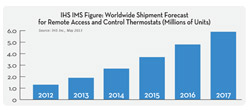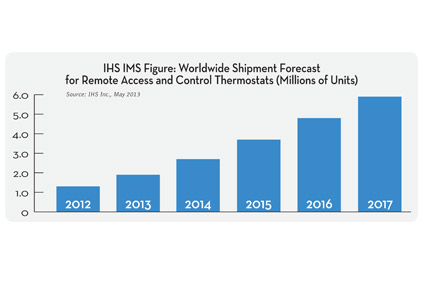 LONDON — Annual shipments of remote access and control thermostats that allow consumers to adjust temperature in homes via a smartphone or tablet will quadruple by 2017, as consumers aim for increased comfort in their residences, according to a report from IMS Research, now part of IHS.
LONDON — Annual shipments of remote access and control thermostats that allow consumers to adjust temperature in homes via a smartphone or tablet will quadruple by 2017, as consumers aim for increased comfort in their residences, according to a report from IMS Research, now part of IHS.
Approximately 3 percent of the 38 million thermostats shipped globally in 2012 gave consumers the ability to remotely adjust the temperature and other comfort settings in their homes through a smartphone or tablet, the study showed. Shipments last year of thermostats with remote access and control functionality amounted to 1.3 million units, with the number projected to increase more than fourfold to 5.9 million units by 2017 (See Figure 1).
The market for remote access and control thermostats is forecast to gain growing interest this year among consumers, with shipments in 2013 for the devices climbing a hefty 46 percent to an estimated 1.9 million units, said IHS.
“With the rising popularity of smartphones and tablets, consumers are increasingly looking to control aspects of their lives through their handheld devices,” said William Rhodes, senior market analyst for the building technologies group at IHS. “Turning up the temperature in your home on a colder day while you are on the train going home is a very appealing proposition,”
The remote-access thermostats — many with built-in Wi-Fi functionality — allow users to carry out a variety of tasks, including changing temperature settings, viewing energy consumption, taking advantage of the latest firmware update from the thermostat provider, and using weather data to optimize the home environment.
While some argue that the ability to change the temperature in one’s home while on vacation could be viewed as somewhat gimmicky, the market continues to incite interest, Rhodes noted, predominately among consumers looking to upgrade older-looking thermostats in their dwellings.
“Historically, consumers were only motivated to install a thermostat when they built a new house or when their furnace, boiler, air conditioner, or even thermostat itself broke,” Rhodes added. “Now, however, remote-access thermostats are creating new demand in the market as consumers look to enhance their comfort levels.”
The ability to control the comfort of one’s home from anywhere in the world is arguably the most heavily publicized trend currently impacting the thermostats market, said IHS.
North America is leading the trend, enjoying a higher shipment penetration than any other global region. Across the U.S. and Canada, an increasing number of new entrants are also heavily promoting the benefits of remote access and control, helping in turn to drive the market overall.
Publication date: 6/24/2013
Want more HVAC industry news and information? Join The NEWS on Facebook, Twitter, and LinkedIn today!


Report Abusive Comment